A Weekly Column By
Mike Johnston
© Mike Johnston 2002
Ah, it’s always lovely coming home from vacation, isn’t it? The house is messier than you remember, there are bills you forgot to pay, and of course there are 350 e-mails, a grocery bag full of mail, and, in my case at least, water in the basement, all awaiting attention.
At the tail end of my vacation this year I got the chance to meet a whole bunch of photographers at one of the most beautiful places in the world. The indefatigable Don Nelson, Mr. Pentax in real life and former official photographer for the Washington Redskins (Don and his friend John Riggins are approximately the same size) invited me to be a presenter at an event called the Camera Clinic atGrandfather Mountain, North Carolina.
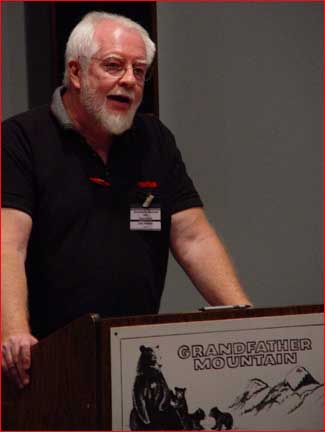
Don Nelson, Director of the Nature Photography Workshop and the Camera Clinic on Grandfather Mountain, near Linville, North Carolina.
Grandfather Mountain (elevation 5,964 ft) is the highest mountain in the Blue Ridge. Although it’s not quite the highest peak in the area, it’s certainly the most dramatic, rising precipitously from the valley floor. The mountain is privately owned and operated as a scenic day attraction and a world-class nature preserve, with bears and bear cubs, cougars, eagles, deer and otters in special habitats. Besides being a favorite day trip for families, hikers, and picnickers from all over the region, it’s also a favorite destination for amateur and professional nature and wildlife photographers.
The "Camera Clinic" is a weekend party thrown for photojournalists and newspaper photographers. Anybody can come‚ there’s no cost, no credentials needed, free food for all. There are several lectures and presentations in the auditorium at the superb museum halfway up the mountain, also free of charge, for photographers.
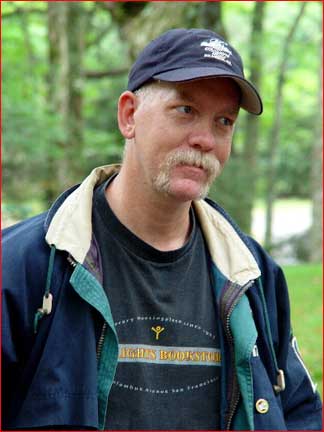
Doug Brewer, Administrator of the Pentax Mailing List and a "Team Member" for the Grandfather Mountain photography weekends.
Although camping on the mountain is normally not allowed, participants at the Camera Clinic and the similar Nature Photography Weekend can stay overnight at the picnic areas. A number of photographers who participate on the Pentax-Discuss Mailing List (PDML) cluster around the camper owned by Bill and Phyllis Owens in the early mornings and late evenings, drawn by the magnet of Bill’s completely unaffected hospitality and Phyllis’s great breakfast cooking.
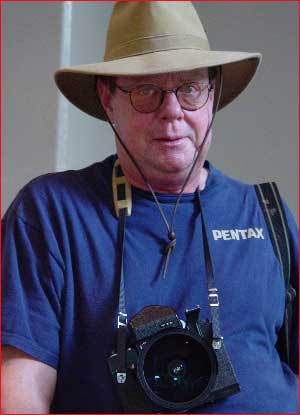
Attendee and unofficial campground host Bill Owens, a guy with a big heart and a camera to match.
As a presenter, I got to stay in one of the nicest little places I’ve ever been‚ a tiny cabin perched on a cliff on the mountainside called Anvil Rock. Built by Grandfather Mountain’s owner, Hugh Morton, and his brother, the tiny cabin is off the beaten path and inaccessible to the public. Anvil Rock itself is actually built into the cabin (or vice-versa). Not ten feet in front of the cabin’s panoramic windows are thetopsof thirty-foot trees! It’s a simply gorgeous location (CBS newsman Charles Kuralt used to use it as a retreat for writing his books). I joked with Hugh and his son Jim Morton that when Nelson dragged me out of the place, my fingernails would make trails on the flagstones. For a writer, it’s an ideal hideaway.
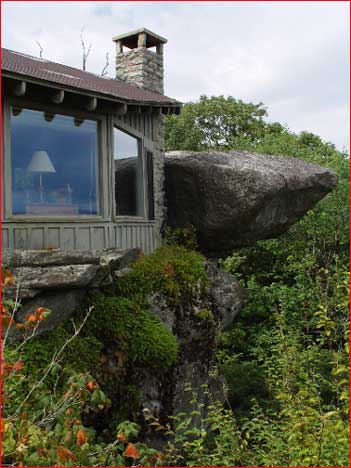
Anvil Rock. Although it’s difficult to see because of the foliage, the one-room cabin is built right on the edge of a dramatic cliff. Anvil Rock itself actually forms part of the front wall of the cabin!
The best part of the weekend for me was meeting all the people and, especially, getting to see the work of my fellow presenters, Don Sturkey and Aristides Economopoulos. First of all, North Carolinians have about the nicest and most natural way of speaking of any English speakers in the world. I’ll tell you, if I emigrated there, I’d be speaking like the natives inside of a week. There’s a nice, relaxed hospitality on the mountain too, that visitors can’t help but notice. Whether this is the famous "southern hospitality" or a unique part of the atmosphere at Grandfather, I can’t say, but I can say that it’s easy to enjoy.
In my own lecture, on Saturday, I harangued the audience on one of my favorite topics: finishing and presenting work so that it can stand for itself. As an "intermission" to my talk, Hugh Morton, who has been a semi-professional photographer for decades, showed examples of work he’s in the middle of making into a retrospective book. An ideal interlude.
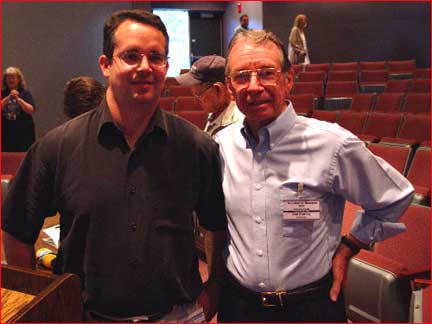
Aris Economopoulos, Southern Photographer of the Year ’01, and Don Sturkey, Southern Photographer of the Year ’62 and ’64.
On Sunday, Don and Aris presented. Don Sturkey was a staff shooter at theCharlotte Observerfor many years, and he was one heck of a shooter. (I can say "was" because Don’s been happily retired for ten years and no longer does much photography.) His black-and-white Tri-X prints of "real life" are the kind of photography that’s close to my own heart; his backstage portrait of Johnny Cash is a masterpiece, and he took probably the best picture ever made of Ray Charles. Speaking selfishly as a photo-book collector, I was delighted to get a signed copy of Don’s out-of-print book,A Slice of Time: A Carolinas Album, 1950-1990. Although the reproductions don’t do justice to the pictures, it’s a fine example of skilled and responsible newspaper work, and every fifth picture or so reaches the heights of the art. If you’re interested, there are a few copies of the book left. They’re available fromJohn F. Blair, Publisher, 1-800-282-9796.
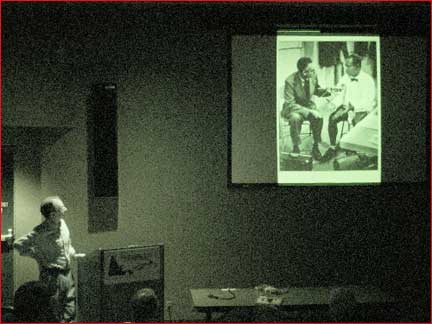
Don Sturkey showing his famous picture of Louis Armstrong being interviewed getting ready for a show. My photo (not Don’s, of course) was taken in the dark by infrared light.
Although Don was a hard act to follow, all of us‚ Don and I included‚ were blown away by the incredible pictures of Aris Economopoulos. Aris was present at Ground Zero on 911. Robert Capa said "If your pictures aren’t good enough, get closer," and Aris took that dictum literally: if you’ve ever seen the famous picture of a lone photographer in silhouette running frantically away from a wall of onrushing debris from the fall of the second tower, well, that was Aris in the picture. Although Aris wasn’t very articulate about his work, he certainly demonstrated visual intelligence‚ I’ve seldom seen more articulate photography. His pictures of 911 are without a doubt the best I’ve ever seen. He’s been widely honored for the work, and never were honors more richly deserved; I think it’s both a body of work that will stand the test of time and that he’ll be proud of for a long time. Aris is a truly gifted shooter in his prime.
I’d never been to North Carolina before, and I sure got a nice introduction. Whether you make the trip for one of the two free photography weekends or just as a destination for your own outdoor photography, Grandfather Mountain is truly a special place.
‚ Mike Johnston
Mike Johnstonwrites and publishes an independent quarterly ink-on-paper magazine calledThe 37th Framefor people who are really "into" photography. His book,The Empirical Photographer, is scheduled to be published in 2003. You can read more about Mike and findadditional articlesthat he has written for this site, as well as aSunday Morning Index.
You May Also Enjoy...
Epson UltraSmooth Paper
In the spring of 2003, at thePMAtrade show in Las Vegas, Epson introduced a new fine-art paper calledUltrasmooth. I was provided with a sample pack
